Football field lighting design is a critical aspect of creating a safe and enjoyable environment for players and spectators alike. At PacLights, we understand the complexities involved in illuminating these large outdoor spaces effectively.
Proper lighting not only enhances visibility but also impacts player performance and the overall spectator experience. This post will explore the key considerations for designing optimal football field lighting systems, from illumination requirements to energy efficiency.
How Bright Should a Football Field Be?
Foot-candles and Lux: The Metrics of Brightness
Football field illumination requires precise measurement and planning. The brightness of a football field is quantified in foot-candles (fc) or lux. Use a professional lighting specifier to determine and provide appropriate light levels as defined by the IES. These levels ensure optimal visibility for players, spectators, and cameras.
The Importance of Even Light Distribution
Uniform lighting plays a vital role in player safety and fair play. The IES recommends a uniformity ratio (the ratio of maximum to minimum light levels) of no more than 1.7:1 for professional fields and 2.5:1 for recreational areas. This means the brightest spots on the field should not exceed 1.7 or 2.5 times the brightness of the darkest spots, respectively.
Vertical Illuminance: A Critical Factor
While horizontal illuminance (light on the ground) often takes center stage, vertical illuminance (light on vertical surfaces) is equally important. It affects players’ ability to see the ball in the air and judge its trajectory. Professional games require a vertical illuminance to ensure optimal visibility for both players and cameras.
Glare Control: Enhancing Visibility and Comfort
Glare can significantly impact player performance and spectator enjoyment. To minimize glare, use fixtures with precise beam control and proper shielding. The Glare Rating (GR) should be controlled according to guidelines for professional and amateur levels.
Adapting to Different Scenarios
Lighting requirements can vary based on specific events. Televised games may require higher light levels to meet broadcasting standards. A flexible lighting system that adjusts to different scenarios can prove invaluable for multi-use facilities.
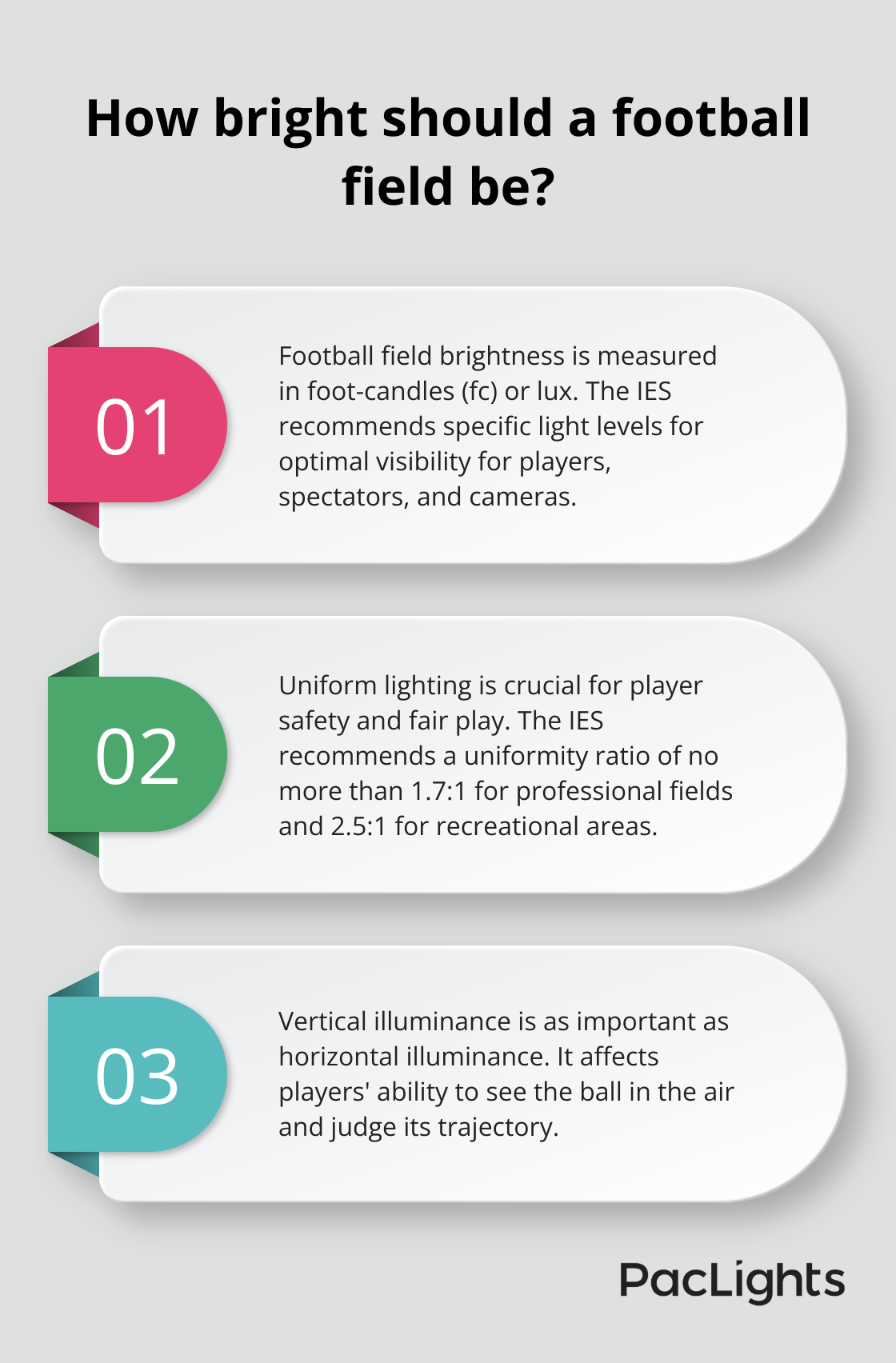
With these brightness considerations in mind, the next step is to select the right light fixtures that can meet these requirements efficiently and effectively.
Selecting the Best Lights for Your Football Field
The LED Revolution in Sports Lighting
LED lights have revolutionized football field illumination. LED lights are more efficient than traditional metal halide fixtures. This significant reduction in energy use makes LED lights the top choice for modern installations.
Advantages of LED Technology
LED lights offer instant on/off capabilities, which eliminates warm-up times. This feature allows quick adjustments during games or events. LEDs also provide better color rendering (with a typical Color Rendering Index of 70 or higher), which enhances visibility for players and spectators alike.
Strategic Fixture Placement
Proper fixture placement ensures uniform illumination across the field. The standard approach uses four to six poles (typically 70-90 feet tall) positioned around the field’s perimeter. However, the exact configuration depends on the field’s size and specific lighting requirements.
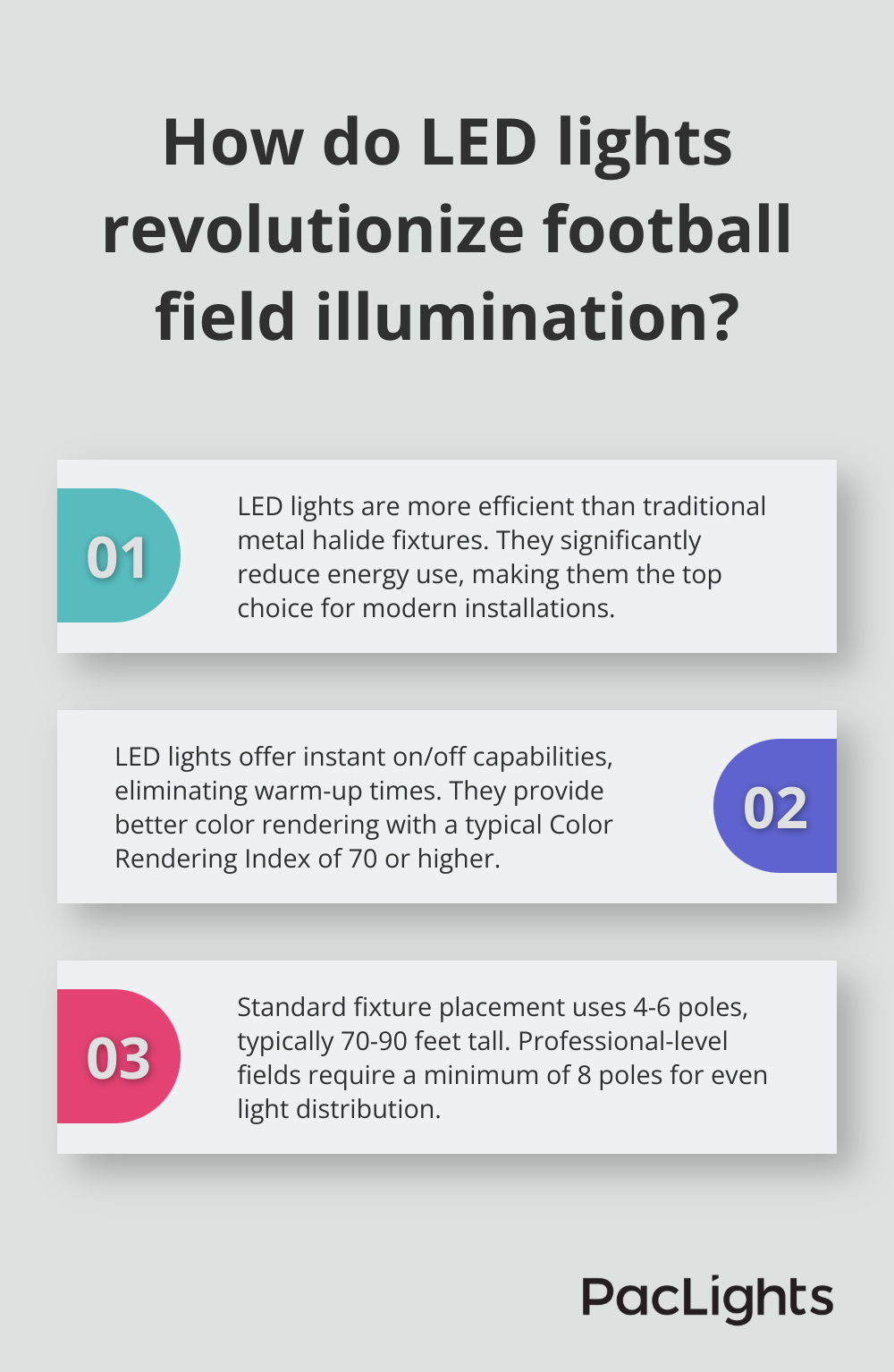
Professional-level fields require a minimum of eight poles to ensure even light distribution and minimize shadows. This setup helps maintain the required uniformity ratios (discussed in the previous section).
Weather-Resistant and Durable Designs
Football fields face various weather conditions, so fixtures must withstand the elements. Fixtures should have an Ingress Protection (IP) rating of at least IP65, which ensures protection against dust and water jets from any direction.
High-quality sports lighting fixtures (such as those offered by PacLights) feature robust construction and corrosion-resistant materials. These outdoor floodlight fixtures withstand harsh environments, which ensures long-term reliability and performance.
Customizable Optics for Precise Light Control
Advanced LED fixtures come with customizable optics that allow precise light control. This feature minimizes light spill and glare, which can affect neighboring properties and create discomfort for players and spectators.
When selecting fixtures, consider options with adjustable beam angles. This flexibility allows fine-tuning of the light distribution to meet specific field requirements and local light pollution regulations.
The next step in creating an optimal football field lighting system involves considering energy efficiency and long-term cost implications. Let’s explore how these factors impact the overall lighting design and operation.
The Financial Impact of Football Field Lighting
Initial Investment vs. Long-Term Savings
Football field lighting represents a significant upfront cost. High-quality LED lighting systems typically range from $200,000 to $1,000,000 (depending on field size and lighting requirements). However, these systems offer substantial long-term savings. LED lights consume up to 75% less energy than traditional metal halide fixtures. For a standard football field, this translates to annual energy savings of $10,000 to $20,000. Over a decade, facilities can save $100,000 to $200,000, which significantly offsets the initial investment.
Smart Controls Enhance Efficiency
Smart lighting controls maximize energy efficiency and cost savings. These systems enable precise scheduling, dimming capabilities, and real-time adjustments based on ambient light conditions or field usage. A smart lighting system can automatically dim lights during practice sessions or adjust brightness levels for different events. This level of control leads to an additional 20-30% in energy savings compared to static LED systems.
Reduced Maintenance Costs
LED lighting is more cost-effective over its lifespan due to lower maintenance costs and energy savings. While metal halide lamps need replacement every 3,000 to 5,000 hours, high-quality LED fixtures can last up to 100,000 hours. This extended lifespan dramatically reduces maintenance costs and the frequency of replacements. A football field using LED lighting may save approximately $20,000 in maintenance costs over a decade compared to traditional lighting systems.
Return on Investment Analysis
When evaluating the financial impact of a football field lighting system, calculating the return on investment (ROI) is essential. The combination of energy savings, reduced maintenance, and improved lighting quality often results in a positive ROI within 3 to 5 years.
Financing Options and Incentives
Facilities can explore various financing options and incentives to offset initial costs. Many utility companies offer rebates for energy-efficient lighting upgrades, which can significantly reduce the upfront investment. Some manufacturers offer leasing options or performance contracts that help spread costs over time.
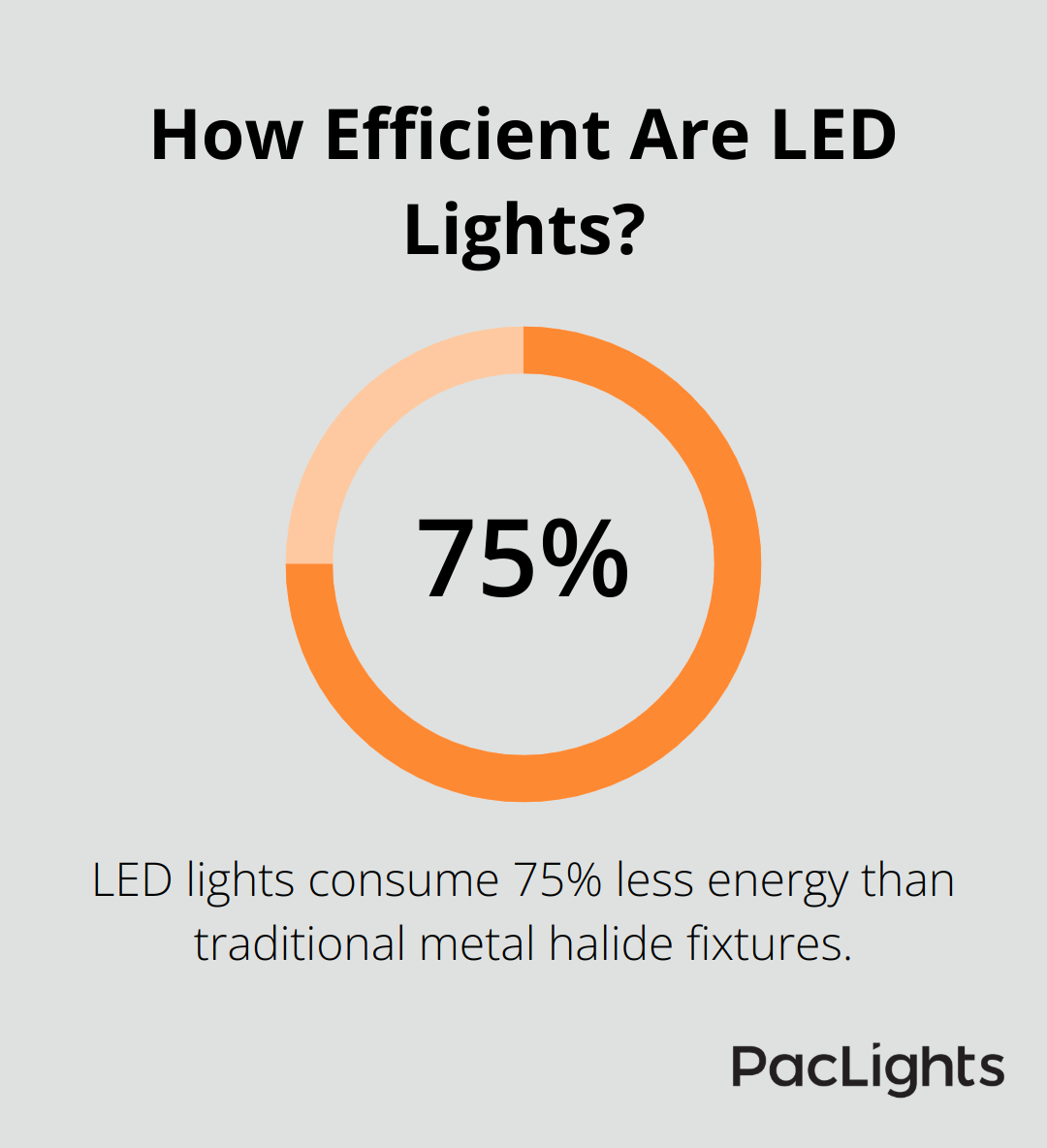
Football field lighting design requires a comprehensive approach to create a safe and enjoyable environment. Professional lighting experts bring essential knowledge of industry standards and technological advancements to achieve optimal results. These specialists ensure lighting systems meet specific requirements for different levels of play while adhering to local regulations and environmental considerations.
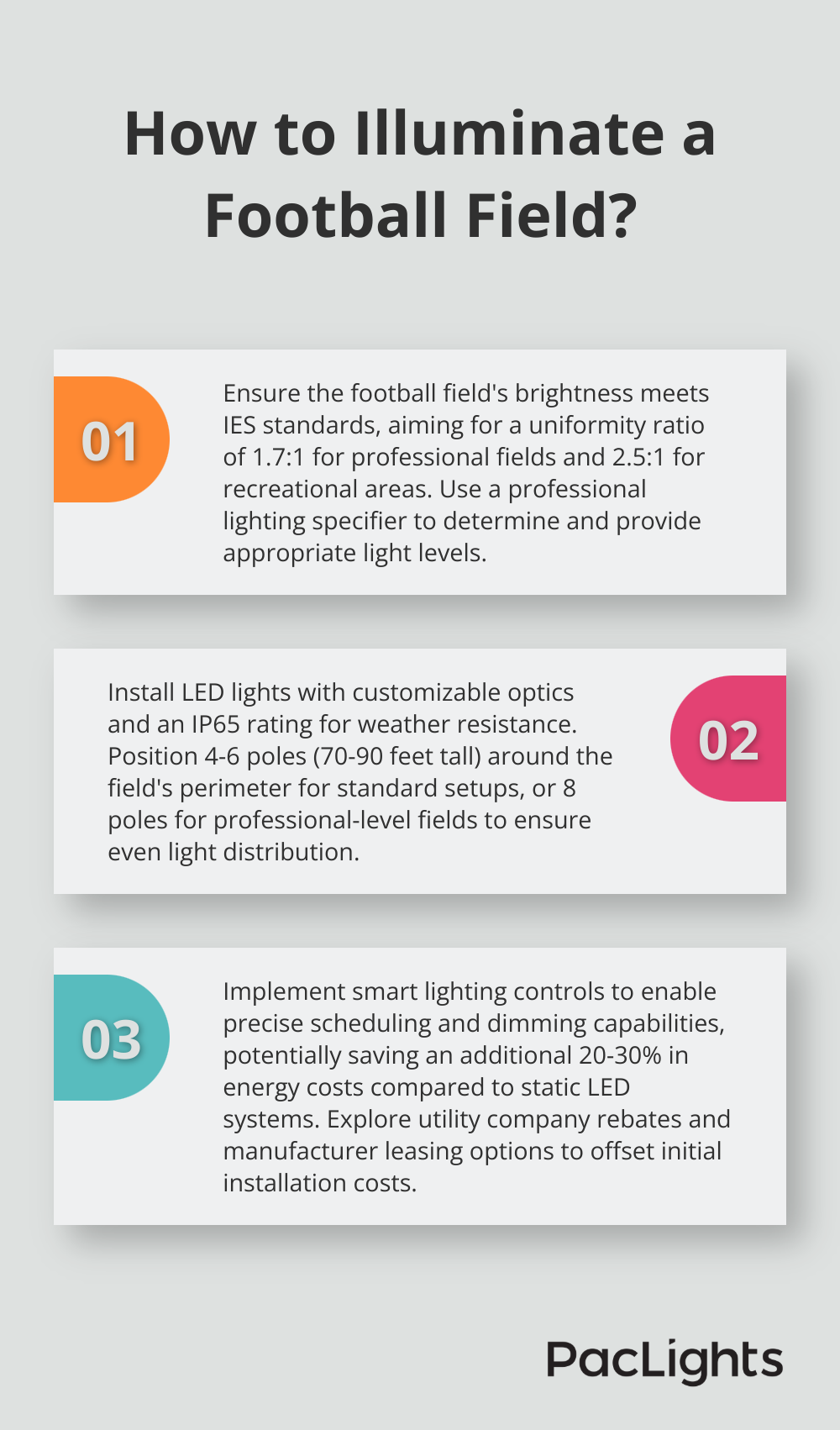
The future of sports lighting technology points towards more intelligent and adaptive systems. These advancements will enhance illumination quality and contribute to energy conservation and cost reduction. LED technology has transformed football field lighting, offering superior performance, longevity, and energy efficiency.
We at PacLights remain committed to staying at the forefront of lighting developments. Our range of lighting solutions meets the diverse needs of football fields and other sports facilities. We offer comprehensive lighting solutions that prioritize performance, efficiency, and sustainability for all your football field lighting design needs.


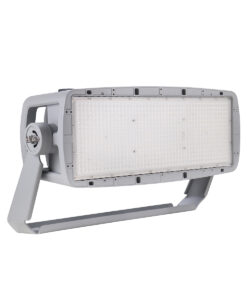
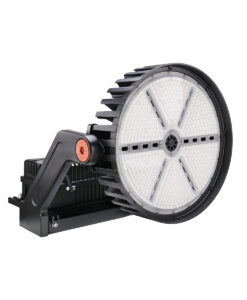
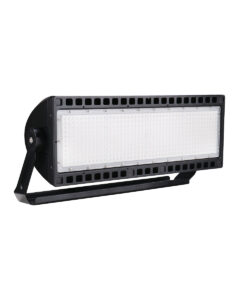
Disclaimer: PacLights is not responsible for any actions taken based on the suggestions and information provided in this article, and readers should consult local building and electrical codes for proper guidance.